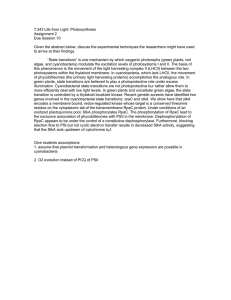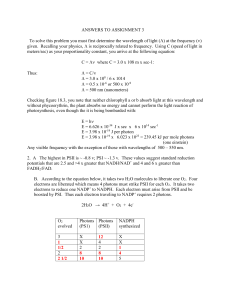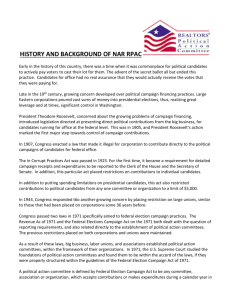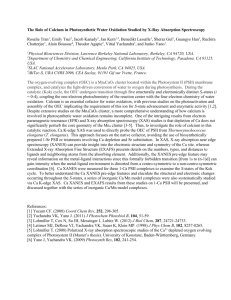Document 13540307
advertisement
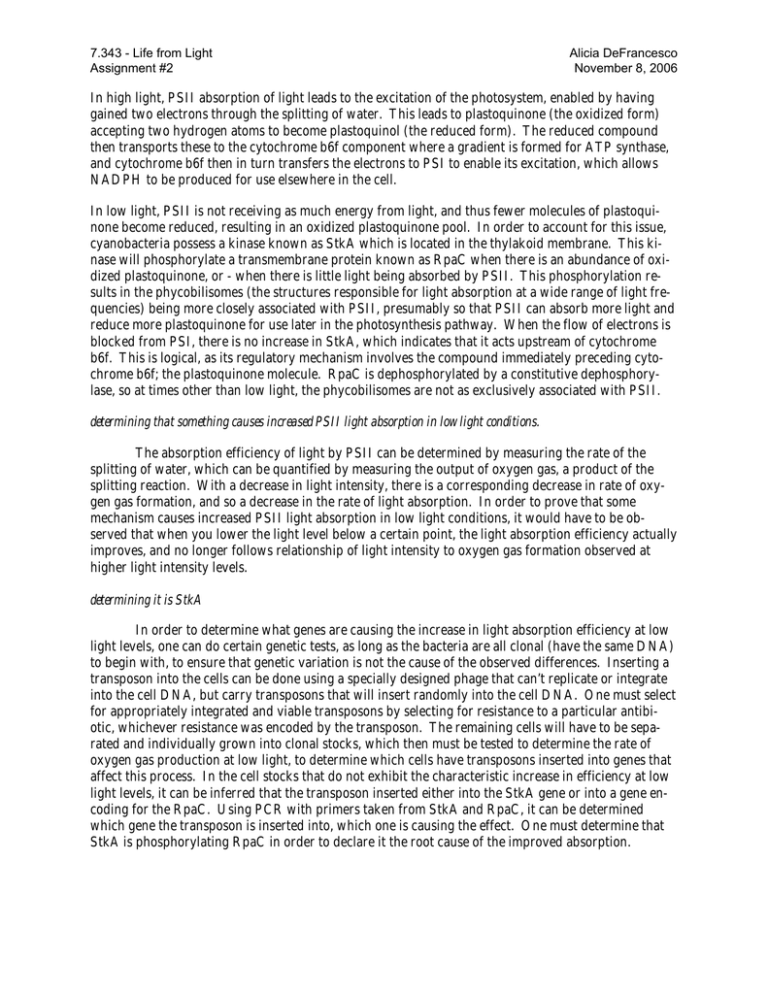
7.343 - Life from Light Assignment #2 Alicia DeFrancesco November 8, 2006 In high light, PSII absorption of light leads to the excitation of the photosystem, enabled by having gained two electrons through the splitting of water. This leads to plastoquinone (the oxidized form) accepting two hydrogen atoms to become plastoquinol (the reduced form). The reduced compound then transports these to the cytochrome b6f component where a gradient is formed for ATP synthase, and cytochrome b6f then in turn transfers the electrons to PSI to enable its excitation, which allows NADPH to be produced for use elsewhere in the cell. In low light, PSII is not receiving as much energy from light, and thus fewer molecules of plastoqui none become reduced, resulting in an oxidized plastoquinone pool. In order to account for this issue, cyanobacteria possess a kinase known as StkA which is located in the thylakoid membrane. This ki nase will phosphorylate a transmembrane protein known as RpaC when there is an abundance of oxi dized plastoquinone, or - when there is little light being absorbed by PSII. This phosphorylation re sults in the phycobilisomes (the structures responsible for light absorption at a wide range of light fre quencies) being more closely associated with PSII, presumably so that PSII can absorb more light and reduce more plastoquinone for use later in the photosynthesis pathway. When the flow of electrons is blocked from PSI, there is no increase in StkA, which indicates that it acts upstream of cytochrome b6f. This is logical, as its regulatory mechanism involves the compound immediately preceding cyto chrome b6f; the plastoquinone molecule. RpaC is dephosphorylated by a constitutive dephosphory lase, so at times other than low light, the phycobilisomes are not as exclusively associated with PSII. determining that something causes increased PSII light absorption in low light conditions. The absorption efficiency of light by PSII can be determined by measuring the rate of the splitting of water, which can be quantified by measuring the output of oxygen gas, a product of the splitting reaction. With a decrease in light intensity, there is a corresponding decrease in rate of oxy gen gas formation, and so a decrease in the rate of light absorption. In order to prove that some mechanism causes increased PSII light absorption in low light conditions, it would have to be ob served that when you lower the light level below a certain point, the light absorption efficiency actually improves, and no longer follows relationship of light intensity to oxygen gas formation observed at higher light intensity levels. determining it is StkA In order to determine what genes are causing the increase in light absorption efficiency at low light levels, one can do certain genetic tests, as long as the bacteria are all clonal (have the same DNA) to begin with, to ensure that genetic variation is not the cause of the observed differences. Inserting a transposon into the cells can be done using a specially designed phage that can’t replicate or integrate into the cell DNA, but carry transposons that will insert randomly into the cell DNA. One must select for appropriately integrated and viable transposons by selecting for resistance to a particular antibi otic, whichever resistance was encoded by the transposon. The remaining cells will have to be sepa rated and individually grown into clonal stocks, which then must be tested to determine the rate of oxygen gas production at low light, to determine which cells have transposons inserted into genes that affect this process. In the cell stocks that do not exhibit the characteristic increase in efficiency at low light levels, it can be inferred that the transposon inserted either into the StkA gene or into a gene en coding for the RpaC. Using PCR with primers taken from StkA and RpaC, it can be determined which gene the transposon is inserted into, which one is causing the effect. One must determine that StkA is phosphorylating RpaC in order to declare it the root cause of the improved absorption. 7.343 - Life from Light Assignment #2 Alicia DeFrancesco November 8, 2006 determining it acts on RpaC (threonine residue) In order to determine which amino acid residue of RpaC the StkA acts on and phosphorylates one can use the sequence and crystal structure of RpaC (if this has already been worked out) to de termine potential sites for phosphorylation; residues that are conducive to phosphorylation by kinase activity in an accessible region of the protein. Once a particular site is determined to be responsible, this can be tested by inducing mutations with UV or other mutagens, determining which of these cre ates a cell that does not have increased light absorption at lower light levels, and then determining where the mutation in those cells occurred. Most point mutations will not cause significant changes to the protein, as often the same residue is substituted, or the structure is not very different from the original. In the few cases that do result in this new phenotype, one could sequence the RpaC region, and determine if the mutations causing this new phenotype are indeed mutations in a specific threo nine residue. determining StkA does not increase with block of electron flow to PSI In order to examine what effect blocking of electron flow to PSI has on the absorption effi ciency of PSII, and thus the activity of StkA, one must first disable cytochrome b6f or plastocyanin in order to stop electron flow to PSI through these compounds. Inhibition of cytochrome b6f can be achieved by using TDS or DBMIB (2,5-dibromo-5-methyl-6-isopropyl-benzoquinone). After success fully inhibiting electron flow to PSI, one can measure the efficiency of PSII at this time by measuring the oxygen gas output. If the efficiency does not increase with the inhibition of electron flow to PSI, it can be concluded that StkA did not increase as a result of this lack of electrons flowing to PSI, and so the kinase must be activated by triggers upstream of cytochrome b6f. The existence of oxidized plas toquinone (or reduced plastoquinole) occurs upstream of cytochrome b6f, and so this experiment would provide more support for the theory that oxidized plastoquinone pools cause StkA to become activated. determining RpaC is dephosphorylated by a constitutive dephosphorylase If the RpaC is dephosphorylated by a constitutive dephosphorylase, it will be dephosphory lated at a certain rate after every instance of being phosphorylated, regardless of the surrounding conditions/situation. If a cell with this gene knocked out has a plasmid inserted into it that has the full gene on it, the function will be regained. Both StkA and the dephosphorylase are regulating the func tion and activity of RpaC by phosphorylating and dephosphorylating the protein at different times, and working out this regulatory pathway would be beneficial to gaining deeper understanding of the mechanism.
